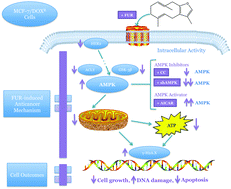Furanodiene alters mitochondrial function in doxorubicin-resistant MCF-7 human breast cancer cells in an AMPK-dependent manner
Abstract
Furanodiene is a bioactive sesquiterpene isolated from the spice-producing Curcuma wenyujin plant (Y. H. Chen and C. Ling) (C. wenyujin), which is a commonly prescribed herb used in clinical cancer therapy by modern practitioners of traditional Chinese medicine. Previously, we have shown that furanodiene inhibits breast cancer cell growth both in vitro and in vivo, however, the mechanism for this effect is not yet known. In this study, therefore, we asked (1) whether cultured breast cancer cells made resistant to the chemotherapeutic agent doxorubicin (DOX) via serial selection protocols are susceptible to furanodiene's anticancer effect, and (2) whether AMP-activated protein kinase (AMPK), which is a regulator of cellular energy homeostasis in eukaryotic cells, participates in this effect. We show here (1) that doxorubicin-resistant MCF-7 (MCF-7/DOXR) cells treated with furanodiene exhibit altered mitochondrial function and reduced levels of ATP, resulting in apoptotic cell death, and (2) that AMPK is central to this effect. In these cells, furanodiene (as opposed to doxorubicin) noticeably affects the phosphorylation of AMPK and AMPK pathway intermediates, ACLY and GSK-3β, suggesting that furanodiene reduces mitochondrial function and cellular ATP levels by way of AMPK activation. Finally, we find that the cell permeable agent and AMPK inhibitor compound C (CC), abolishes furanodiene-induced anticancer activity in these MCF-7/DOXR cells, with regard to cell growth inhibition and AMPK activation; in contrast, AICAR (5-aminoimidazole-4-carboxamide-1-β-4-ribofuranoside, acadesine), an AMPK activator, augments furanodiene-induced anticancer activity. Furthermore, specific knockdown of AMPK in MCF-7/DOXR cells protects these cells from furanodiene-induced cell death. Taken together, these findings suggest that AMPK and its pathway intermediates are promising therapeutic targets for treating chemoresistant breast cancer, and that furanodiene may be an important chemical agent incorporated in next-generation chemotherapy protocols.

- This article is part of the themed collection: Chemical Biology in Molecular BioSystems

 Please wait while we load your content...
Please wait while we load your content...